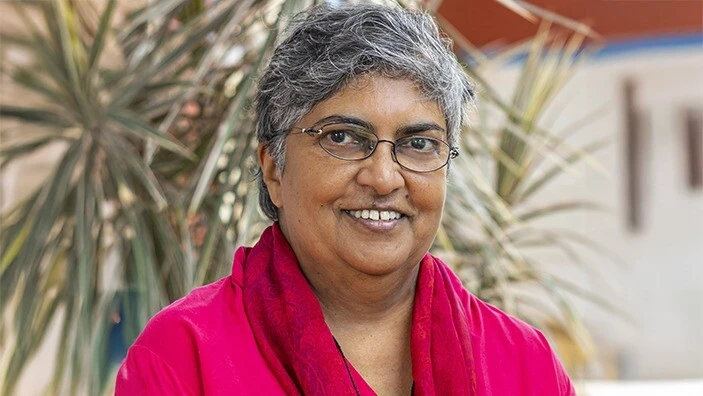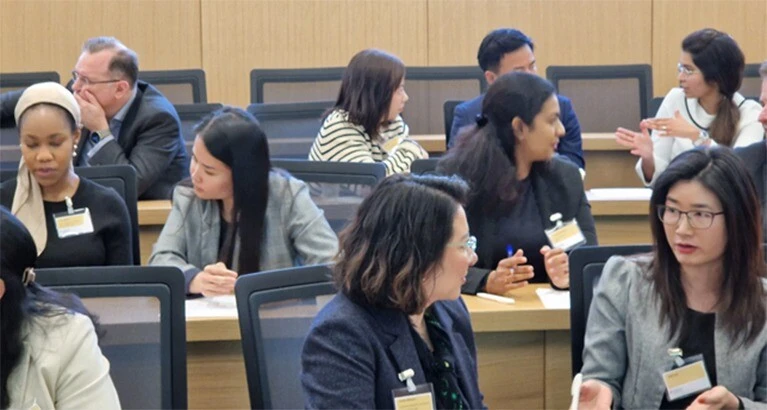Two of the newest members of the Cambridge Judge Business School faculty focus their research on the workplace, examining issues ranging from non-standard work (such as the gig economy) to diversity within teams in order to better understand how the modern working world operates.
Elizabeth George, KPMG Professor of Management Studies, and Prithviraj Chattopadhyay, Professor of Organisational Behaviour, arrived in Cambridge in autumn 2023 after an 11,000-mile journey from Auckland, New Zealand, following 7 years at the University of Auckland Business School. Their previous train stops have included studies in India and in Austin, Texas (where both earned their PhDs), and academic posts in Hong Kong, Sydney, Brisbane, and Michigan.
Their research has featured in some of the leading business and psychology journals in the world, including the Academy of Management Journal, Administrative Science Quarterly, Organization Science, and Journal of Applied Psychology.


3 studies focus on diversity in teams in the workplace
To introduce our readers to Elizabeth and Prithviraj, we focus in this article on 3 studies in recent years they conducted jointly or individually that focus on important issues of the workplace:
- geographical differences within teams
- gender-dissimilarity
- pay-grade disparity
Although the studies are very different, they all have a common theme: how do people of diverse characteristics – be it gender, location/origin, or status – best function in an organisation to achieve positive organisational results? “Underlining all 3 studies is the idea that individuals use demographic attributes to sort themselves and their teammates into in-groups versus out-groups that are assigned high versus low status,” says Prithviraj. “People wish to enhance their sense of self through either competing for status or collaborating with high-status colleagues, depending on what is seen to be possible within the context of the status hierarchy governing their interactions.
“We were drawn to these topics because we have observed so many examples of groups and individuals who thrive in conditions of dissimilarity and those that don’t. We were curious about why they had these different outcomes”, adds Elizabeth”.
People wish to enhance their sense of self through either competing for status or collaborating with high-status colleagues, depending on what is seen to be possible within the context of the status hierarchy governing their interactions
1. The impact of first impressions in geographically diverse teams
It’s a fact of modern workplace life that people work in geographically diverse teams – diverse in that people are physically located in many parts of the world in today’s Zoom-enabled offices and homes, and diverse in that people working in the same physical office may come from all parts of a nation or from around the globe.
So how do people influence and interact in such geographically varied teams?
A study co-authored by Prithviraj and Elizabeth in the Academy of Management Journal focuses on the emotions experienced by team members in their very first meetings, and how these emotions influence the effect of geographical dissimilarities over time.
In 2 studies based among MBA students in Hong Kong and India, the paper finds that among individuals who experience pleasant emotions in initial meetings the geographical dissimilarity with colleagues is more positively related with perceived influence in the initial stage of a project as they tend to create a positive impression from the beginning. But for those experiencing unpleasant emotions such as sadness in first impressions, such geographic dissimilarity is instead related with perceived influence in later stages of a project. Sadness signals to individuals that there is a problem to solve, leading them to gain influence over time.
As for those experiencing unpleasant emotions such as anger in initial meetings, the study found that it was more of a roller-coaster: “Their geographic dissimilarity was initially positively and later negatively related with perceived influence”, the paper finds, attributing the initial positive effect to the energy generated by anger.
Exploring how team motivation is shaped by feelings and distance
The practical implications of these findings are that for organisations to realise the benefits of diversity for team performance it is important to understand these consequences, because the emotions experienced and level of geographical dissimilarity can shape the motivation of team members and their ability to work effectively with colleagues and thus be perceived as influential by them.
“Our results show that the geographical dissimilarity of teammates could either facilitate or hinder the emergence of team member influence at different points in a project, depending on those team members’ initial emotional experiences,” the study finds. Due to the tendency of individuals to remain consistent in their view over time, their initial pattern of interactions with dissimilar colleagues endures over the life of a project.
Business schools were chosen as the study’s setting because they are places that bring together people from around the world to learn and network together. The first study sample totalled 192 people belonging to 27 countries led in numbers by China, the US, Canada, and India, with a range of full-time employment of 2 to 14 years. The second study included 338 people in 75 teams of 5 to 7 members from 23 states in India associated with differences in language or dialect and salient aspects of their culture.
The study in the Academy of Management Journal – entitled “Geographical dissimilarity and team member influence: do emotions experienced in the initial team meeting matter?” – is co-authored by Prithviraj Chattopadhyay and Elizabeth George, now at Cambridge Judge Business School; Jiping Li of Frankfurt School of Finance & Management, and Vishal Gupta of the Indian Institute of Management in Ahmedabad, India.
Our results show that the geographical dissimilarity of teammates could either facilitate or hinder the emergence of team member influence at different points in a project, depending on those team members’ initial emotional experiences.
2. Males unwilling to accept female leaders can shape team dynamics
Research over many years has suggested that male subordinates are less willing to accept female leaders compared to female subordinates – but how does this shape team dynamics involving other members of the team?
A study co-authored by Prithviraj in the Journal of Applied Social Psychology finds that males who are unwilling to accept a female leader may seek to shape the group dynamic by inviting other male team members to develop their own influence within the team.
Such men may also seek to increase their own intra-team influence through ‘competence monitoring’ (behaviour to boost their own influence), and especially when there is a greater proportion of male peers in the team. That’s “because men (more than women) are likely to disengage from the team, rather than actively seeking influence within the team, when there are fewer same‐gender peers in the team,” the study says.
What is the impact of gender dissimilarity between team members?
The research differs from previous studies in that it focuses not only on the gender of the team leader but also to team members’ gender dissimilarity to the leader, so this allows the study “to explore the individual‐level behaviours and outcomes of subordinates” – not in isolation but instead in the context of other team members with the same supervisor.
The research is based on a survey of 288 members of 61 research and development teams (R&D teams were chosen because they work closely together toward a common goal) at 11 high-tech companies in Beijing, 7 of them in the biopharmaceutical field, 2 in electronics and 2 in transportation. Male team members and male leaders accounted for 55.2% and 72.1% of the sample, respectively, and the average age was 28.28 years for team members and 33.36 years for team leaders.
In summary: “Our findings suggest that individual team members’ motivation to use competence monitoring to gain influence in their team is shaped by the combination of their gender, the team leader’s gender, and their peers’ gender. Awareness of these dynamics can be useful when designing a team.”
The study in the Journal of Applied Social Psychology – entitled “Team members’ reactions to a gender-dissimilar leader: competence monitoring and influence” – was co-authored by Jiping Li of the Frankfurt School of Finance & Management; Daan van Knippenberg of Rice University in Houston, Texas; Prithviraj Chattopadhyay, now at Cambridge Judge Business School; and Wen Wu of Beijing Jiaotong University.
Our findings suggest that individual team members' motivation to use competence monitoring to gain influence in their team is shaped by the combination of their gender, the team leader's gender, and their peers' gender.
3. Legitimate pay discrepancy can boost team identification and performance
Pay discrepancy within organisations and within teams can breed envy and resentment, and this reflects human nature. Many studies have looked at this issue from a broad organisational perspective, but research by Elizabeth and Prithviraj takes a more nuanced approach focused on individuals and their immediate teams.
The findings: working with teammates with a different pay grade can have beneficial effects on individuals by reducing social uncertainty in their work relationships – and this can boost their team identification and performance while lowering their turnover intention, particularly for team members in a lower pay grade. But there is a big caveat: this works only when team members perceive the pay discrepancy to be legitimate and stable.
This is more the case when considering pay grade rather than pay itself, “because higher grades are associated with higher education and skills that presumably result in greater value for the organisation… or are associated with better performance on the part of the individual… Some combination of education, skill and performance form the basis of determining pay grades in most organisations.”
Most research on pay discrepancy has been conducted at collective levels (company-wide or workforce-wide) to look at conditions under which pay dispersion is beneficial or harmful to the organisation, but the study co-authored by Elizabeth and Prithviraj (published in the Academy of Management Journal) instead examines how pay difference affects people through a process termed “uncertainty reduction”.
Why pay grade disparities need to be studied within team rather than across organisation
“We focus particularly on pay grade differences between teammates because teams form the building blocks of today’s organisations, and interactions with teammates, more so than with colleagues in the broader organisation, are salient features of the everyday life of team members that shape their social self-concept,” the study says.
The research is based on members and leaders of 40 marketing teams from a telecommunications company in China that develop marketing plans, provide customer services and manage customer relationships. Within each team are jobs with associated pay grades based on the worth of those jobs to the company, and team members with greater skills and knowledge are recruited for jobs with more responsibility.
The study says it is “the first to suggest that working with dissimilar teammates may lead to reduced uncertainty regarding issues like who provides leadership who is more a follower, and the social pecking order in the team, and thereby facilitate identification with the team. Our study demonstrates that people can embrace differences in teams and realise the informational benefits related to dissimilarity when they perceive that status differences related to dissimilarity are legitimate and stable.”
The study in the Academy of Management Journal – entitled “Not in my pay grade: the relational benefit of pay grade dissimilarity” – is co-authored by Lida L. Zhang of the University of Macau and by Elizabeth George and Prithviraj Chattopadhyay, now of Cambridge Judge Business School.
We focus particularly on pay grade differences between teammates because teams form the building blocks of today’s organisations, and interactions with teammates, more so than with colleagues in the broader organisation, are salient features of the everyday life of team members that shape their social self-concept
Featured faculty
Elizabeth George
KPMG Professor of Management Studies
Prithviraj Chattopadhyay
Professor of Organisational Behaviour
Featured research
Chattopadhyay, P., George, E., Li, J. and Gupta, V. (2020) “Geographical dissimilarity and team member influence: do emotions experienced in the initial team meeting matter?” Academy of Management Journal, 63(6): 1807-1839 (DOI: 10.5465/amj.2017.0744)
Li, J., van Knippenberg, D., Chattopadhyay, P. and Wu, W. (2022) “Team members’ reactions to a gender-dissimilar leader: competence monitoring and influence.” Journal of Applied Social Psychology, 52(10): 1002-1016 (DOI: 10.1111/jasp.12908)
Zhang, L.L., George, E. and Chattopadhyay, P. (2020) “Not in my pay grade: the relational benefit of pay grade dissimilarity.” Academy of Management Journal, 63(3): 779-801 (DOI: 10.5465/amj.2016.1344)





